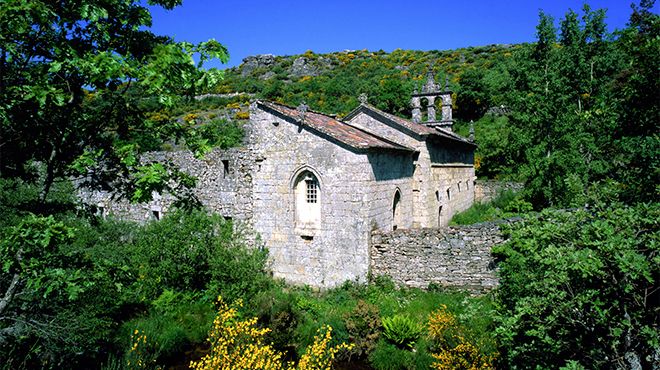Mosteiro de Santa Maria das Júnias

Mosteiro de Santa Maria das Júnias
Monuments
This is the most isolated of all the Cistercian churches in Portugal, set in a valley surrounded by mountain peaks, close to the border with Galicia. To reach the church, visitors must walk 200 metres down into the valley, but the site's uniquely magical atmosphere is a fine reward for all the effort.
The monastic life was carried on here from the 9th century onwards, and the monastery was incorporated into the Cistercian Order in the 13th century, although it is not known for certain whether the mother-house was at Santa Maria do Bouro or at the Monastery of Santa Maria de Oseira, in Galicia, the coat of arms of which can be seen on the doorway leading to the monastic buildings. All that remains of the monastery itself is a few buildings close to the river.
The church has a Romanesque structure, although the apse has narrow Gothic windows. The Maltese cross has been cut out of the stone on the main façade. Remaining from the original cloister are a segment of an arcade and the wing backing onto the apse of the church, running parallel to the river bank, where the monks used to sleep. In the other wing, one can see the kitchen space and its beautiful chimney. A small river flows gently by the side of the monastery, adding to the unique charm of this particular spot.
The last Cistercian monk to live here became the parish priest in the village of Pitões das Júnias, in 1834, the year when the Religious Orders were suppressed in Portugal.
By way of historical curiosity, it is interesting to note that D. Pedro de Pitões, one of the main driving forces behind the conquest of Lisbon from the Moors in 1147, was ordained Bishop of Porto at this monastery.
The monastic life was carried on here from the 9th century onwards, and the monastery was incorporated into the Cistercian Order in the 13th century, although it is not known for certain whether the mother-house was at Santa Maria do Bouro or at the Monastery of Santa Maria de Oseira, in Galicia, the coat of arms of which can be seen on the doorway leading to the monastic buildings. All that remains of the monastery itself is a few buildings close to the river.
The church has a Romanesque structure, although the apse has narrow Gothic windows. The Maltese cross has been cut out of the stone on the main façade. Remaining from the original cloister are a segment of an arcade and the wing backing onto the apse of the church, running parallel to the river bank, where the monks used to sleep. In the other wing, one can see the kitchen space and its beautiful chimney. A small river flows gently by the side of the monastery, adding to the unique charm of this particular spot.
The last Cistercian monk to live here became the parish priest in the village of Pitões das Júnias, in 1834, the year when the Religious Orders were suppressed in Portugal.
By way of historical curiosity, it is interesting to note that D. Pedro de Pitões, one of the main driving forces behind the conquest of Lisbon from the Moors in 1147, was ordained Bishop of Porto at this monastery.
Contacts
Address:
5470-370 Pitões das Júnias - Montalegre




 Explore
Explore 
 Remember and Share
Remember and Share 


